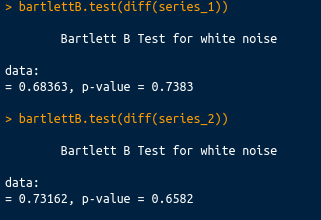Let's run Augmented Dickey Fuller tests
So which one is a random walk?
-ACF show no auto-correlation on the differenced series
-Periodograms(differenced series) look (somehow) like white noise
-Regressions have slopes too close to 1
-Both unit root tests imply compatibility with the random walk hypothesis
Reminder X_t~RW if ΔX_t~N(0,σ)
White noise hypothesis not rejected in any of the two



















